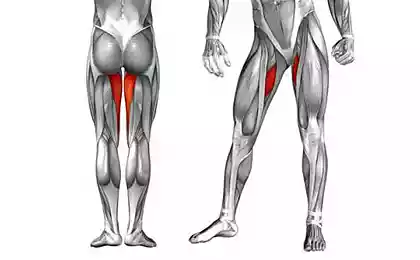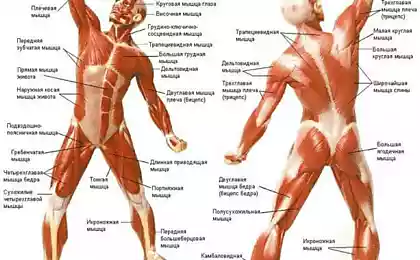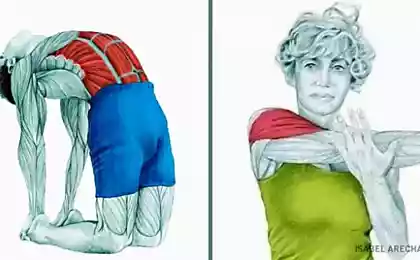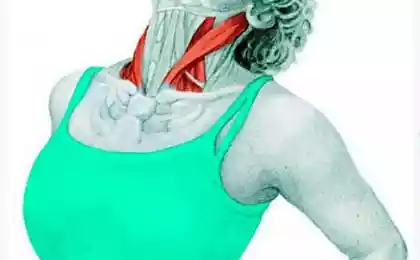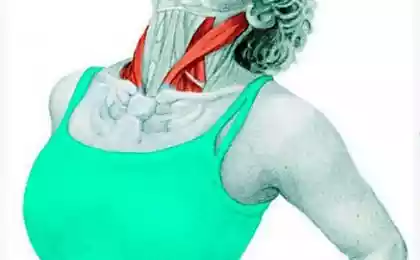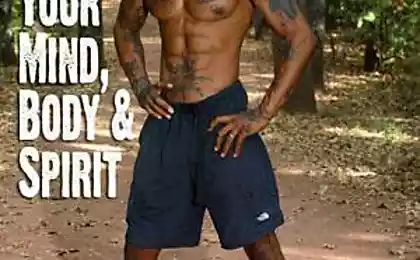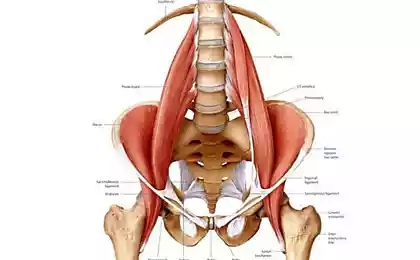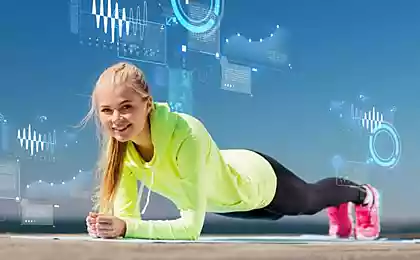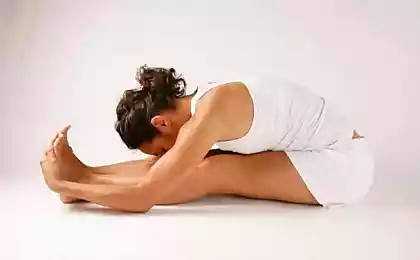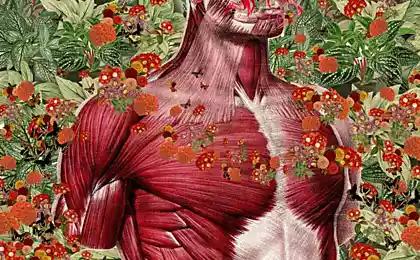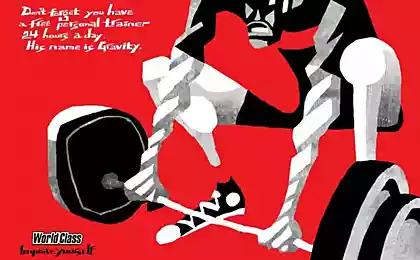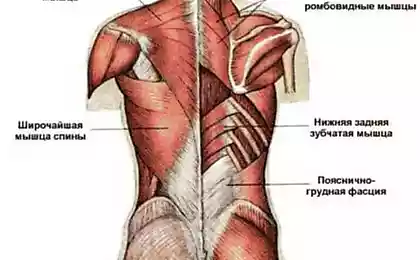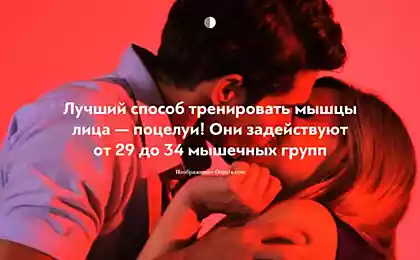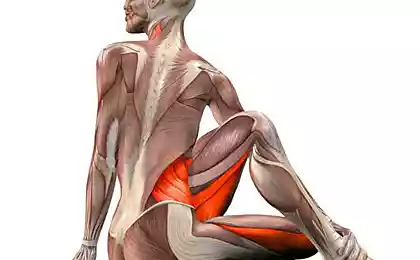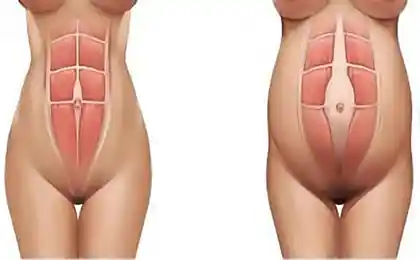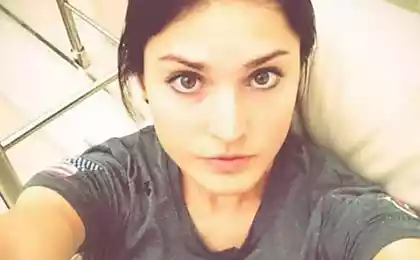470
7 ignored muscles that make it difficult to gain muscle mass
Experts describe the most "neglected" muscles and tell why they are important and how to strengthen them, getting a super body without injury.
The rotator cuff
The deltoid muscle is the size of a grapefruit — they will not be the same if you tear rotary cuff of the shoulder, group of four muscles that in a literal sense form a "cuff" to stabilize the shoulder joint. Damage it and you will limit the range of motion will make movement at the top, head over to painful.

"The shoulders are the most flexible, but therefore they are also the most unstable," says Tom Holland, a specialist in the study of methods of improving athletic performance, master, author of "Training in the details: the Secrets of a personal trainer". Keep them in shape, it is better to do before "that", not after. Usually it is start to do after the injury, though I had to do to her.
Strengthen: Do the move just like a student raises his hand to answer, without taking his elbow from the Desk from "the hands are one above the other on the Desk". Bend your arm at the elbow 90 degrees and hold it in front of the body at the level of the solar plexus. With the help of the deltoids move the arm at 45 degrees from the body, keeping the 90 degree angle at the elbow. Very similar to how the student is sitting at her Desk, hands folded on one another in front of him on the Desk (in our case only one arm is such a position). Now do the rotation in the shoulder joint outwards (if right arm, then right) the elbow when it is bent at 90 degrees, keep the angle of 45 between the shoulder and the housing. If we return to the example with a student, he turns his hand without removing his elbow from the table (ie as it raises a hand, wanting to answer), but do it in the air. Return your arm to its original position. Do this exercise for 10-12 reps for each side.
Muscle, straightening the torso
Perhaps you are working on top of the back, trying to improve it, but probably neglected the most important muscles that make your back straight. Rectifiers spins are a group of muscles and tendons that pass through the upper, middle and lower parts of the back. "For posture, they mean much more than the other," says Holland. "Rectifiers weak back and poor posture can lead to back pain and sports injuries".
Strengthening: Lie face down on a bench for training of back extensors, stabilize the heel (you can use a fitness ball if you have a partner who will keep you at your heels). Put your hands behind your head, elbows move to the sides. Slowly straighten your torso (without twisting) until it forms a straight line formed by the ears, shoulders, hips, knees, heels. Slowly return to starting position. Do three sets of 10-12 repetitions.
Middle and small gluteal muscle
A few muscles get as much attention as the gluteus Maximus, but it does not allow it to reach full development without these two little-known accessory muscles that serve to stabilize the pelvis, this is particularly important when standing on one leg, the guy says to Andrew, "master of arts", a specialist in the study of methods of improving athletic performance: "They are vital for the development of any athlete is a key in walking and climbing stairs. Plus, when they are in good shape, they support the gluteus Maximus muscle."
Strengthen: Use the hard pie trainer-expander (rubber expander, connected to the circle in two diametrically opposite points of a circle fixed cuff with buckles). Stand in a circle with both feet, fasten the cuffs on each ankle. Feet wider than shoulders, knees slightly bent, toes stretched up, hands on hips or stomach. Take a step outside-to-face, make 8-10 steps, then repeat in the opposite direction. Do 2-3 sets 2-3 times a week.
Anterior tibial muscle
Have you ever suffered from pains in the front part of the Shin? If so, listen carefully: insufficient development of this vital muscle that runs along the bottom of the leg, and on the tibia, plays an important role in the formation of a normal gait, and can increase the risk of nagging foot pain.
"Anterior tibial muscle plays a vital role in walking, running and sprints," says Andrew.
Strengthen: Take 2-3 times a week following exercise: Sit in a chair, feet flat on the floor, keeping your heels on the floor, lift your toes up, repeat 8-10 times. For better results, you can raise the toe a small dumbbell weight 2-3 kg to increase the load. You can also sit on a high chair or bench, so that his feet hung from it, and perform the same exercise by hanging a dumbbell between the feet.
Obliques
No upgrades in the world won't make you a "washing Board" (chastisement press) on your stomach without working on these muscles. Oblique muscles include the inner and outer muscles, which run diagonally from the lower chest to the pubic area. "Functionally, they support your body in a straight position," says Andrew. "Visually they form a border around the middle part of the abdomen. The problem is that most people are sure that they train this area slopes to the sides, but this group of muscles when it doesn't work."
Strengthen: Do double lifts. Lie on your back with straight legs, feet at a distance of 50 centimeters, hands behind his head. Twist the body, pulling the right elbow left knee, keeping the opposite arm in the initial position, and the leg outstretched. Exhale during the rotation, think about how the ribs are compressed in the direction of the hips. Then return to the starting position. Pause, repeat the exercise in the opposite direction. Do 2-3 times a week for 8-10 reps.
Hamstring
I'm sure all those squats, wall thrust and lunges indirectly train this muscle group — but not enough. "Most guys concentrate on the quads and ignore the lower part of the thigh," says Andrew, who believes that the lower part of the thigh, only 60 percent has the power of the quads. What's the problem? Any imbalance in a pair of the flexor-extensor, quads strong — weak lower thigh violates their collaboration. In this particular case, it may cause injury to the knees (so said Andrew, who has recently damaged the anterior cruciate ligament in the knee during a jump over a puddle while Jogging).
Strengthen: to Be effective exercise machines for bending, or leg extension, you can try to bend the leg using the ball. Lie on the floor, heels on the ball, the toes of the feet pointing up to the ceiling, legs slightly bent. Lift your hips, pressing the ball with his heels, then roll the ball to his heels, to the place on which you usually sit, kneecaps pointing to the ceiling. Keeping the hips off the floor, roll the ball back to the starting position, then repeat. Do 8-10 repetitions, 2-3 times a week.
Extensors of the forearm
Since these muscles are designed to hold weights such as dumbbells and barbells, their weakness is stopping you to train other, larger muscles and "weaken" exercise in General — not counting your backhand in tennis, of course. "We use the forearm muscles for all pulling movements, with flexion of hands and even with the bench press the triceps, but use them only when lifting on a biceps by a reverse grab," says Eve Rubenstein, Ph. D., trainer and physiologist, founder of the fitness facility S. T. E. P. S. in Nashville, Tennessee.
Strengthen: while watching TV you can squeeze and release a tennis ball, doing 3 sets of 10 repetitions 2-3 times a week. Or try this: tie a small weight on the end of a rope, the other end of the rope tie to the MOP handle or wooden stick. Standing extend your arms in front of him with a stick in his hands, wrap the rope with weight on the stick, turning it alternating movements of the hands, then unroll, rotating brushes, in the opposite direction. Make 2-3 repeat.
P. S. And remember, just changing your mind — together we change the world! ©
Source: vk.com/sport_stat
The rotator cuff
The deltoid muscle is the size of a grapefruit — they will not be the same if you tear rotary cuff of the shoulder, group of four muscles that in a literal sense form a "cuff" to stabilize the shoulder joint. Damage it and you will limit the range of motion will make movement at the top, head over to painful.

"The shoulders are the most flexible, but therefore they are also the most unstable," says Tom Holland, a specialist in the study of methods of improving athletic performance, master, author of "Training in the details: the Secrets of a personal trainer". Keep them in shape, it is better to do before "that", not after. Usually it is start to do after the injury, though I had to do to her.
Strengthen: Do the move just like a student raises his hand to answer, without taking his elbow from the Desk from "the hands are one above the other on the Desk". Bend your arm at the elbow 90 degrees and hold it in front of the body at the level of the solar plexus. With the help of the deltoids move the arm at 45 degrees from the body, keeping the 90 degree angle at the elbow. Very similar to how the student is sitting at her Desk, hands folded on one another in front of him on the Desk (in our case only one arm is such a position). Now do the rotation in the shoulder joint outwards (if right arm, then right) the elbow when it is bent at 90 degrees, keep the angle of 45 between the shoulder and the housing. If we return to the example with a student, he turns his hand without removing his elbow from the table (ie as it raises a hand, wanting to answer), but do it in the air. Return your arm to its original position. Do this exercise for 10-12 reps for each side.
Muscle, straightening the torso
Perhaps you are working on top of the back, trying to improve it, but probably neglected the most important muscles that make your back straight. Rectifiers spins are a group of muscles and tendons that pass through the upper, middle and lower parts of the back. "For posture, they mean much more than the other," says Holland. "Rectifiers weak back and poor posture can lead to back pain and sports injuries".
Strengthening: Lie face down on a bench for training of back extensors, stabilize the heel (you can use a fitness ball if you have a partner who will keep you at your heels). Put your hands behind your head, elbows move to the sides. Slowly straighten your torso (without twisting) until it forms a straight line formed by the ears, shoulders, hips, knees, heels. Slowly return to starting position. Do three sets of 10-12 repetitions.
Middle and small gluteal muscle
A few muscles get as much attention as the gluteus Maximus, but it does not allow it to reach full development without these two little-known accessory muscles that serve to stabilize the pelvis, this is particularly important when standing on one leg, the guy says to Andrew, "master of arts", a specialist in the study of methods of improving athletic performance: "They are vital for the development of any athlete is a key in walking and climbing stairs. Plus, when they are in good shape, they support the gluteus Maximus muscle."
Strengthen: Use the hard pie trainer-expander (rubber expander, connected to the circle in two diametrically opposite points of a circle fixed cuff with buckles). Stand in a circle with both feet, fasten the cuffs on each ankle. Feet wider than shoulders, knees slightly bent, toes stretched up, hands on hips or stomach. Take a step outside-to-face, make 8-10 steps, then repeat in the opposite direction. Do 2-3 sets 2-3 times a week.
Anterior tibial muscle
Have you ever suffered from pains in the front part of the Shin? If so, listen carefully: insufficient development of this vital muscle that runs along the bottom of the leg, and on the tibia, plays an important role in the formation of a normal gait, and can increase the risk of nagging foot pain.
"Anterior tibial muscle plays a vital role in walking, running and sprints," says Andrew.
Strengthen: Take 2-3 times a week following exercise: Sit in a chair, feet flat on the floor, keeping your heels on the floor, lift your toes up, repeat 8-10 times. For better results, you can raise the toe a small dumbbell weight 2-3 kg to increase the load. You can also sit on a high chair or bench, so that his feet hung from it, and perform the same exercise by hanging a dumbbell between the feet.
Obliques
No upgrades in the world won't make you a "washing Board" (chastisement press) on your stomach without working on these muscles. Oblique muscles include the inner and outer muscles, which run diagonally from the lower chest to the pubic area. "Functionally, they support your body in a straight position," says Andrew. "Visually they form a border around the middle part of the abdomen. The problem is that most people are sure that they train this area slopes to the sides, but this group of muscles when it doesn't work."
Strengthen: Do double lifts. Lie on your back with straight legs, feet at a distance of 50 centimeters, hands behind his head. Twist the body, pulling the right elbow left knee, keeping the opposite arm in the initial position, and the leg outstretched. Exhale during the rotation, think about how the ribs are compressed in the direction of the hips. Then return to the starting position. Pause, repeat the exercise in the opposite direction. Do 2-3 times a week for 8-10 reps.
Hamstring
I'm sure all those squats, wall thrust and lunges indirectly train this muscle group — but not enough. "Most guys concentrate on the quads and ignore the lower part of the thigh," says Andrew, who believes that the lower part of the thigh, only 60 percent has the power of the quads. What's the problem? Any imbalance in a pair of the flexor-extensor, quads strong — weak lower thigh violates their collaboration. In this particular case, it may cause injury to the knees (so said Andrew, who has recently damaged the anterior cruciate ligament in the knee during a jump over a puddle while Jogging).
Strengthen: to Be effective exercise machines for bending, or leg extension, you can try to bend the leg using the ball. Lie on the floor, heels on the ball, the toes of the feet pointing up to the ceiling, legs slightly bent. Lift your hips, pressing the ball with his heels, then roll the ball to his heels, to the place on which you usually sit, kneecaps pointing to the ceiling. Keeping the hips off the floor, roll the ball back to the starting position, then repeat. Do 8-10 repetitions, 2-3 times a week.
Extensors of the forearm
Since these muscles are designed to hold weights such as dumbbells and barbells, their weakness is stopping you to train other, larger muscles and "weaken" exercise in General — not counting your backhand in tennis, of course. "We use the forearm muscles for all pulling movements, with flexion of hands and even with the bench press the triceps, but use them only when lifting on a biceps by a reverse grab," says Eve Rubenstein, Ph. D., trainer and physiologist, founder of the fitness facility S. T. E. P. S. in Nashville, Tennessee.
Strengthen: while watching TV you can squeeze and release a tennis ball, doing 3 sets of 10 repetitions 2-3 times a week. Or try this: tie a small weight on the end of a rope, the other end of the rope tie to the MOP handle or wooden stick. Standing extend your arms in front of him with a stick in his hands, wrap the rope with weight on the stick, turning it alternating movements of the hands, then unroll, rotating brushes, in the opposite direction. Make 2-3 repeat.
P. S. And remember, just changing your mind — together we change the world! ©
Source: vk.com/sport_stat

